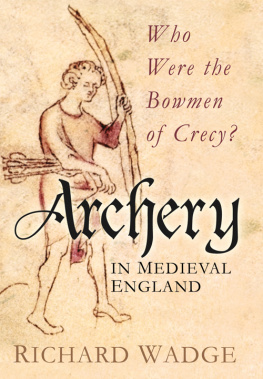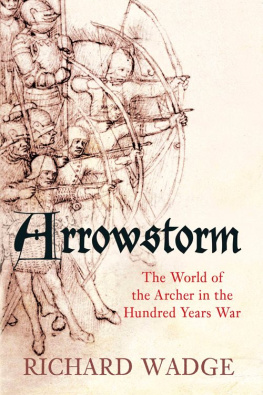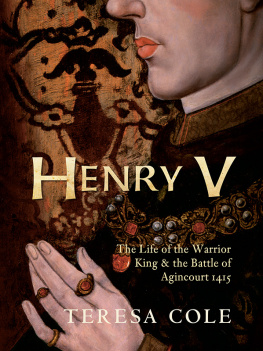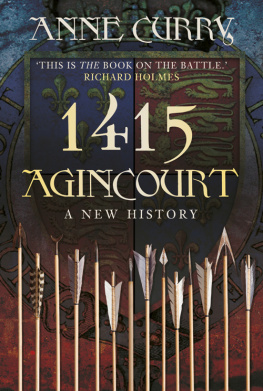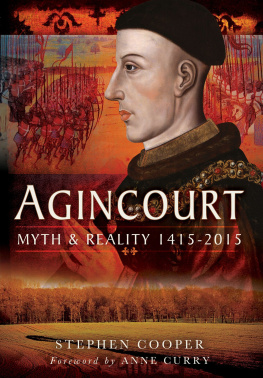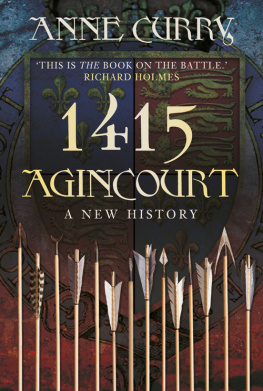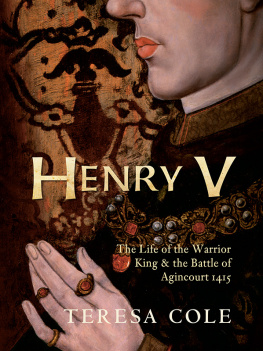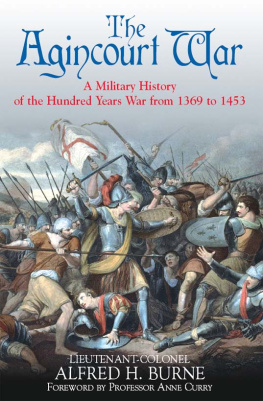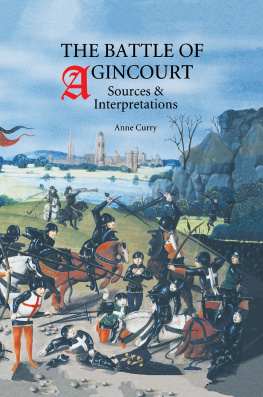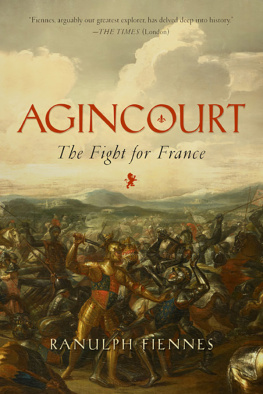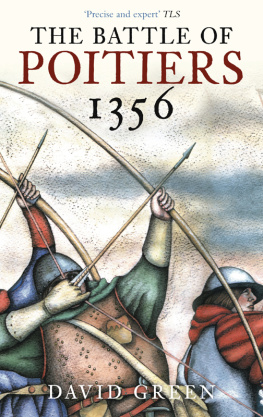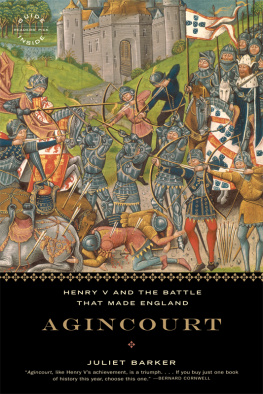
P eople in all three of the countries involved in the Battle of Verneuil have freely given me generous help while I have been writing this book.
Roselyne Millet, the Directrice of the Jrme Carcopino Municipal Library in Verneuil supplied material which gave the French point of view. Jean Baptiste Pierrat and Frdric Jurczyk in the Tourist Information Office in Verneuil were very patient and helpful with the random Englishman who appeared in the office one damp Saturday.
Staff of Historic Scotland, particularly Malcolm Irving, sorted out pictures of monuments in response to my enquiries. Jason Sutcliffe, who works for East Ayrshire Council in the Future Museum, also made sure I found the best images from their collection to meet my needs.
Just as happened in the battle, the Italians made an important contribution, thanks to the staff of the photographic office of the Uffizi Gallery in Florence.
Yet again the cheerful professionalism of the staff of the Bodleian Library in Oxford has been a great help.
My son Edmund read the early chapters and provided penetrating advice which made me clarify things.
Finally, but by no means the smallest contribution, Eleanor gave cheerful, tolerant support to a husband living in the fifteenth century.
Thanks to you all.
Contents
1
E ngland and France waged the Hundred Years War between 1337 and 1453. While relations between the two kingdoms were more likely to be hostile than amiable between the Norman Conquest and the end of the Napoleonic Wars, hostility was more persistent during these years. There were times, such as c. 134056 and 141535, when the fighting was almost continuous with some large-scale battles and sieges, and there were other times, such as c. 13901410, when life was almost peaceful. The original cause of the war was that according to English law, Edward III had a good claim to the French throne through his mother, Isabella, who was daughter of Philip IV of France. Unsurprisingly, the French claimed that the ancient Salic law of the Franks excluded inheritance of royal power through the female line. Edward was not prepared to accept this slight. However, relations between the kings of England and France were made more complicated by the English king claiming to be Duke of Normandy and Duke of Aquitaine, which meant that he owed feudal fealty to the King of France for these lands. These were matters that were never going to be resolved solely by diplomacy or legal argument. But it is also fair to say that war became something of a habit among the English at this time.
This habit was fuelled by the longer running warfare between England and Scotland. Once the Hundred Years Warstarted England was in a pincer between Scotland to the north and France over the Channel to the south. There were two major areas of dispute between England and Scotland in the Middle Ages, which were as insoluble as was the dispute over the French throne: where was the border between the two kingdoms, and was the King of Scotland subject to the English king? Edward I had managed to establish a shaky English suzerainty, but it crumbled under his weak successor, Edward II. He could not counter Robert Bruce, Robert I of Scotland, a heroic figure who led his kingdom to independence. While a series of victories in Edward IIIs reign taught the Scots to avoid provoking the English king, these two issues ensured that there was never more than a truce on the border. The Scots and the French agreed treaties in the fourteenth century to support each other against England the Auld Alliance, which is described in a later chapter.
Englands two long wars came together in the fateful meeting of the armies of the three kingdoms at Verneuil in 1424.
The years of the Hundred Years War would have been eventful enough in western Europe without warfare between the two kingdoms. In 134750 the Black Death killed around 40 per cent of the population of Europe, but this only quietened the war for a couple of years. This dreadful cull of the population gave opportunities to the survivors; ordinary men and women had a scarcity value which gave them some economic power and choice. Towns and cities continued their rapid growth in much of western Europe, despite the ravages of war in France in particular. Local and international trade grew with the towns, and the great commercial cities of the Italian peninsula began to send their trading fleets full of exotic goods (and more ordinary items like high quality bowstaves for the English war-bow) to the ports of northern and western Europe.
What is perhaps most surprising in the period between 1380 and 1420 is the remarkable coincidences in the political upheavals in the three kingdoms of England, Scotland and France. There were deeply divisive struggles between the king and the magnates and among the magnates themselves in all three countries. All three countries had an incompetent king for a period. Robert III of Scotland may have had some long-term physical disability after his accident in 1388 but he seems to have become vacillating and desperate to please many of his nobles. He was succeeded by a minor, James, who also happened to be a prisoner in England. Richard II of England became a capricious, self-indulgent ruler who found it very difficult to trust anyone outside his immediate circle. His successor Henry IV always had a problem because some people felt he was not a legitimate king because he had deposed Richard II. This may have led to him being plagued by self-doubt. But as his reign progressed, he increasingly suffered from sustained serious ill health which affected his ability to rule. At the same time, France was rent by feuding between the royal dukes and their supporters, because King Charles VI of France had increasingly frequent bouts of insanity, which necessitated a regency for much of the last thirty years of his reign. Yet despite these problems the three kingdoms managed to continue their desultory, often bloody struggles for supremacy.
At this time of tragedy and change, when the people needed spiritual support the most, the papacy was in a state of decay. It had been based in southern France at Avignon since 1309 where it gained an unenviable reputation for corruption and partiality. Then, from 1378 western Christendom ended up with two popes for forty years. Despite these problems with the leadership of Christendom, this was a period of deep personal faith, but that could be something very different from a deep faith in the spirituality of the Catholic Church. Some theologians and preachers put forward ideas that, with hindsight, we would regard as being the foundations of Protestantism.
The Hundred Years War inevitably led to a number of developments in military practice. The best known of these are the use of the English war-bow and the development of gunpowder artillery. The development of professional non-noble armies was just as important. The success of the English armies, wherein everyone fought on foot regardless of rank and most of the soldiers were archers, was a great surprise in Continental Europe. It went against the tradition that noble, mailed and armoured horsemen were the most important and effective fighting men on the battlefield. The English armies werent the only ones that demonstrated the power of good infantry against armoured cavalry. The Scots showed that pike-armed infantry could defeat cavalry at Bannockburn against the English and the Flemings proved much the same point at Courtrai against the French. But the English were the only ones who used infantry archers to defeat armoured cavalry. The other surprise was that it was the English who were so successful. They had never been a major European military power in their own right before, although England had been an important part of Henry IIs Angevin Empire in the twelfth century.
Next page

